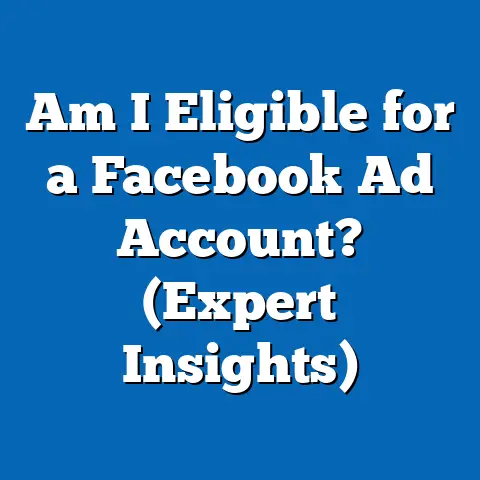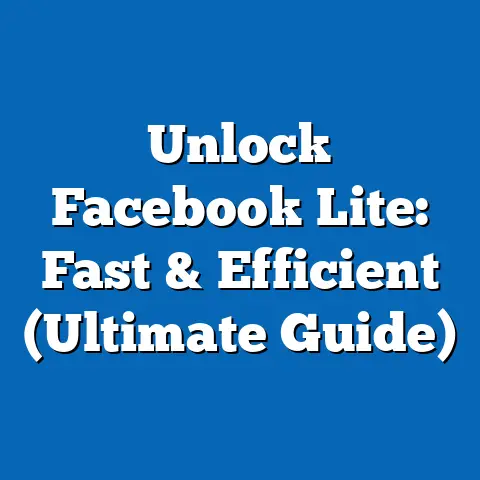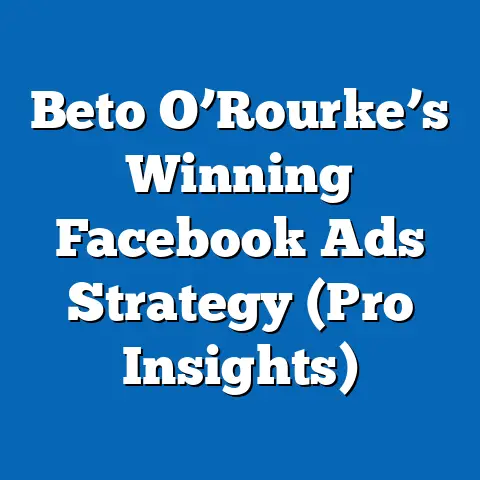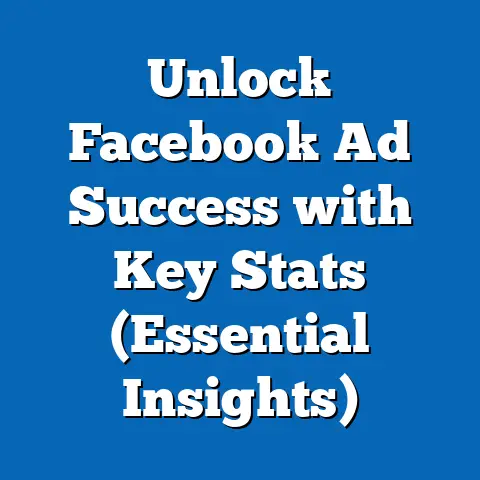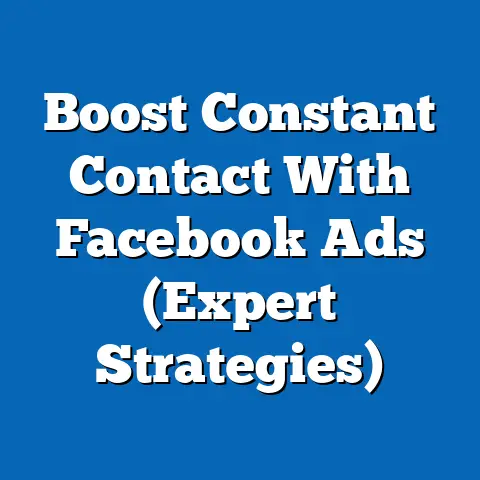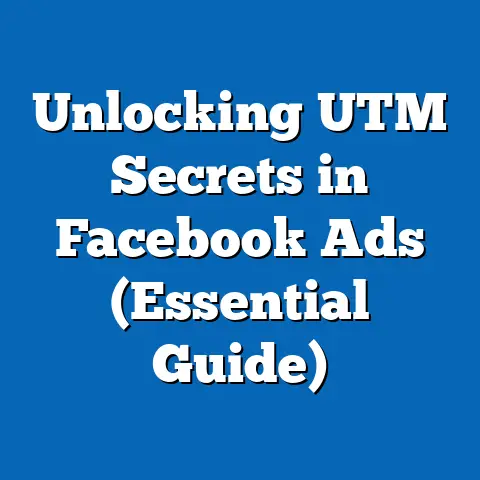Boost Conversions with Facebook Automated App Ads (Pro Strategies)
Imagine you’re an explorer setting sail on a vast ocean. Your destination? A thriving community of app users, ready to embrace your creation. But the sea is treacherous, filled with competing ships (other apps) and unpredictable currents (ever-changing user preferences). This, in essence, is the challenge of app marketing today. Just like Odysseus’s journey home, the voyage to successful app conversions requires strategy, resilience, and a powerful guiding force. In the world of app marketing, that force is Facebook Automated App Ads.
I’ve spent years navigating the complexities of Facebook advertising, and I’ve seen firsthand how Automated App Ads can be a game-changer for app developers and marketers. They offer a streamlined, efficient way to reach your target audience, optimize your campaigns, and ultimately, boost your app’s performance. But simply setting up an ad and hoping for the best isn’t enough. You need a strategic approach, a deep understanding of the platform, and a willingness to adapt and optimize.
Section 1: Understanding Facebook Automated App Ads
Definition and Overview
Facebook Automated App Ads, also known as Advantage+ app campaigns, are a powerful advertising solution designed to simplify and optimize the process of promoting mobile apps across the Facebook ecosystem. This includes Facebook, Instagram, Audience Network, and Messenger. Think of them as a sophisticated autopilot system for your app marketing efforts. Instead of manually managing every aspect of your campaign, you provide Facebook with the necessary inputs (your app, your target audience, your budget), and the platform’s advanced algorithms take over, automatically optimizing your ads for maximum performance.
The core idea is to leverage Facebook’s vast data and machine learning capabilities to identify the most effective ad placements, targeting options, and creative combinations to drive app installs, in-app events, and ultimately, a positive return on investment (ROI). The beauty of automation lies in its ability to continuously learn and adapt, improving campaign performance over time without requiring constant manual intervention.
Essentially, it’s about letting the platform’s sophisticated AI do the heavy lifting, freeing you up to focus on the bigger picture – crafting compelling app experiences and developing innovative marketing strategies.
The Importance of App Advertising
In today’s mobile-first world, app advertising is no longer a luxury; it’s a necessity. Consider these statistics:
- Mobile app usage is booming: According to Statista, the average smartphone user spends over 4 hours per day using apps. This represents a massive opportunity for businesses to connect with their target audience through mobile experiences.
- The app economy is huge: The global app market is projected to reach over $407.31 billion in revenue by 2026 (Source: Statista). This demonstrates the immense economic potential of mobile apps and the need for effective marketing strategies to capture a share of this growing market.
- Organic app discovery is challenging: With millions of apps available on app stores, standing out from the crowd organically is incredibly difficult. App advertising provides a crucial pathway to increase visibility and drive downloads.
Facebook, with its massive user base and sophisticated targeting capabilities, offers an unparalleled platform for app promotion. Here’s why it’s a critical channel for app marketers:
- Unmatched reach: Facebook boasts billions of active users worldwide, providing access to a diverse and expansive audience.
- Granular targeting: Facebook’s advanced targeting options allow you to reach specific demographics, interests, behaviors, and even custom audiences based on your existing customer data.
- High engagement: Facebook users are highly engaged with the platform, spending significant time browsing content, connecting with friends, and discovering new products and services.
- Data-driven optimization: Facebook’s advertising platform provides robust analytics and reporting tools, allowing you to track campaign performance, identify areas for improvement, and optimize your ads for maximum ROI.
Takeaway: App advertising is essential for success in the modern mobile landscape, and Facebook offers a powerful platform for reaching your target audience and driving app growth. By leveraging Automated App Ads, you can streamline your campaigns, optimize performance, and achieve your app marketing goals.
Section 2: Setting the Stage for Success
Before diving headfirst into creating ads and launching campaigns, it’s crucial to lay a solid foundation for success. This involves identifying your target audience and setting clear, measurable objectives. Think of it as preparing the soil before planting seeds. Without fertile ground, even the best seeds won’t flourish.
Identifying Your Target Audience
Understanding your target audience is paramount to any successful marketing campaign, and app advertising is no exception. You need to know who you’re trying to reach, what their interests are, and what motivates them to download and use your app.
Here’s where Facebook’s Audience Insights tool comes into play. This powerful tool provides valuable data and insights about your potential customers, allowing you to refine your targeting and create ads that resonate with them.
Here’s how I use Audience Insights to identify my target audience:
- Start with your existing customer data: If you have a list of existing app users, upload it to Facebook as a custom audience. This allows you to analyze their demographics, interests, and behaviors, providing a valuable starting point for identifying your target audience.
- Explore potential interests: Brainstorm a list of interests that are relevant to your app. For example, if you’re promoting a fitness app, you might explore interests like “weightlifting,” “yoga,” “healthy eating,” and “running.”
- Analyze demographic data: Use Audience Insights to analyze the demographics of people who are interested in these topics. Pay attention to age, gender, location, education level, and relationship status.
- Identify key behaviors: Explore the behaviors of your target audience, such as their online purchasing habits, their mobile device usage, and their engagement with different types of content.
- Refine your targeting: Based on your findings, create a detailed profile of your ideal app user. This will serve as a guide for creating targeted ads that resonate with your audience.
Example:
Let’s say you’re launching a new language learning app. Using Audience Insights, you might discover that your target audience consists primarily of:
- Millennials and Gen Z (ages 18-35)
- Located in urban areas
- Interested in travel, foreign cultures, and personal development
- Likely to use mobile apps for learning and entertainment
- Engaged with content related to language learning, travel, and cultural exchange
With this information, you can create highly targeted ads that speak directly to their interests and motivations, increasing the likelihood of downloads and engagement.
Setting Clear Objectives
Setting clear, measurable objectives is essential for tracking your campaign’s progress and ensuring that you’re achieving your desired results. Without clear goals, it’s impossible to determine whether your efforts are paying off.
I always use the SMART framework to set my objectives:
- Specific: Clearly define what you want to achieve.
- Measurable: Establish metrics to track your progress.
- Achievable: Set realistic goals that are within reach.
- Relevant: Ensure that your objectives align with your overall business goals.
- Time-bound: Set a deadline for achieving your objectives.
Here are some common objectives for app advertising campaigns:
- Increase app downloads: This is the most common objective, focusing on driving a high volume of installs.
- Example: Increase app downloads by 20% in the next month.
- Drive in-app purchases: If your app monetizes through in-app purchases, focus on driving users to make purchases.
- Example: Increase in-app purchase revenue by 15% in the next quarter.
- Enhance user engagement: Focus on increasing user activity and retention within your app.
- Example: Increase the average session length by 10% in the next two weeks.
- Acquire new users with high lifetime value: Focus on attracting users who are likely to become long-term, valuable customers.
- Example: Acquire 500 new users with a projected lifetime value of $50 each in the next month.
- Example: Increase app downloads by 20% in the next month.
- Example: Increase in-app purchase revenue by 15% in the next quarter.
- Example: Increase the average session length by 10% in the next two weeks.
- Example: Acquire 500 new users with a projected lifetime value of $50 each in the next month.
Takeaway: By identifying your target audience and setting clear, measurable objectives, you’ll be well-positioned to create effective Facebook Automated App Ads that drive results. Remember to use Facebook’s Audience Insights tool to refine your targeting and the SMART framework to set achievable goals.
Section 3: Crafting Compelling Ads
Now that you have a solid understanding of your target audience and your campaign objectives, it’s time to focus on creating compelling ads that grab attention and drive conversions. Your ad creative is the first impression you make on potential users, so it’s crucial to make it count.
Ad Creative Essentials
Effective ad creative consists of three key components: visuals, copy, and a call-to-action (CTA). Each element plays a crucial role in capturing attention, conveying your message, and driving users to take action.
- Visuals: Your visuals should be eye-catching, relevant, and high-quality. Use images or videos that showcase your app’s features, benefits, and user interface. Consider using animated GIFs or short video clips to grab attention and demonstrate your app’s functionality.
- Pro Tip: Facebook recommends using high-resolution images and videos with a 1:1 (square) or 9:16 (vertical) aspect ratio for optimal performance on mobile devices.
- Copy: Your ad copy should be concise, engaging, and persuasive. Highlight the key benefits of your app and explain why users should download it. Use strong verbs and compelling language to create a sense of urgency and excitement.
- Pro Tip: Keep your copy short and sweet, focusing on the most important benefits of your app. Use bullet points or numbered lists to highlight key features.
- Call-to-action (CTA): Your CTA should be clear, concise, and action-oriented. Use a strong verb that encourages users to download your app, such as “Install Now,” “Download Now,” or “Get Started.”
- Pro Tip: Test different CTAs to see which ones perform best with your target audience. Consider using a CTA that is specific to your app, such as “Start Learning Now” or “Book Your First Class.”
- Pro Tip: Facebook recommends using high-resolution images and videos with a 1:1 (square) or 9:16 (vertical) aspect ratio for optimal performance on mobile devices.
- Pro Tip: Keep your copy short and sweet, focusing on the most important benefits of your app. Use bullet points or numbered lists to highlight key features.
- Pro Tip: Test different CTAs to see which ones perform best with your target audience. Consider using a CTA that is specific to your app, such as “Start Learning Now” or “Book Your First Class.”
Example:
Let’s say you’re promoting a meditation app. Here’s an example of effective ad creative:
- Visual: A calming image of a person meditating in a peaceful setting.
- Copy: “Find inner peace and reduce stress with our meditation app. Download now and start your journey to mindfulness.”
- CTA: “Download Now”
A/B Testing for Optimization
A/B testing, also known as split testing, is the process of comparing two versions of an ad to see which one performs better. This is a crucial step in optimizing your ad creative and maximizing your campaign’s ROI.
I always recommend testing different elements of your ad creative, such as:
- Visuals: Test different images or videos to see which ones resonate best with your audience.
- Copy: Test different headlines, body copy, and descriptions to see which ones drive the most clicks and conversions.
- CTAs: Test different CTAs to see which ones encourage the most downloads.
- Targeting: Test different targeting options to see which audiences are most responsive to your ads.
Here’s a step-by-step guide on how to conduct A/B tests on Facebook:
- Create two versions of your ad: Change only one element at a time to accurately measure the impact of that specific change.
- Set up your A/B test in Facebook Ads Manager: Use the “A/B Test” campaign objective to easily create and manage your tests.
- Allocate your budget: Divide your budget evenly between the two versions of your ad.
- Run your test for a sufficient period: Allow enough time for the test to gather statistically significant data. Facebook recommends running A/B tests for at least 4-7 days.
- Analyze the results: Use Facebook Ads Manager to track the performance of each version of your ad. Pay attention to metrics such as impressions, clicks, click-through rate (CTR), and conversions.
- Implement the winning version: Once you’ve determined which version of your ad performs better, implement it in your main campaign.
- Repeat the process: A/B testing is an ongoing process. Continuously test different elements of your ad creative to optimize your performance over time.
Takeaway: Crafting compelling ad creative is essential for driving conversions. Use high-quality visuals, engaging copy, and clear CTAs to capture attention and encourage downloads. Conduct A/B tests to optimize your ad creative and maximize your campaign’s ROI. Remember to test one element at a time to accurately measure the impact of each change.
Section 4: Leveraging Facebook’s Automation Tools
Facebook’s automation tools are designed to simplify and optimize your app advertising campaigns, allowing you to focus on the bigger picture while the platform handles the day-to-day tasks. Two key automation tools are dynamic ads and automated rules.
Dynamic Ads and Automated Rules
- Dynamic Ads: Dynamic ads automatically show the most relevant products or services to potential customers based on their interests and behaviors. For app advertising, this means showcasing different features, benefits, or use cases of your app to different users.
- How they work: You upload a catalog of your app’s features or benefits to Facebook, and the platform automatically creates ads that are tailored to each user’s interests.
- Benefits: Dynamic ads can significantly improve your campaign performance by showing users the most relevant content, increasing the likelihood of downloads and engagement. They also save you time and effort by automating the ad creation process.
- Automated Rules: Automated rules allow you to automatically make changes to your campaigns based on specific triggers. For example, you can set up a rule to automatically pause an ad that is underperforming or to increase the budget for an ad that is exceeding expectations.
- How they work: You define the conditions that trigger the rule and the actions that should be taken when those conditions are met.
- Benefits: Automated rules can help you optimize your campaigns in real-time, ensuring that you’re always maximizing your ROI. They also save you time and effort by automating repetitive tasks.
- How they work: You upload a catalog of your app’s features or benefits to Facebook, and the platform automatically creates ads that are tailored to each user’s interests.
- Benefits: Dynamic ads can significantly improve your campaign performance by showing users the most relevant content, increasing the likelihood of downloads and engagement. They also save you time and effort by automating the ad creation process.
- How they work: You define the conditions that trigger the rule and the actions that should be taken when those conditions are met.
- Benefits: Automated rules can help you optimize your campaigns in real-time, ensuring that you’re always maximizing your ROI. They also save you time and effort by automating repetitive tasks.
Example:
Let’s say you’re promoting an e-commerce app. You can use dynamic ads to automatically show users products that they’ve previously viewed on your website or app. You can also use automated rules to automatically pause ads that have a CTR below a certain threshold or to increase the budget for ads that are driving a high volume of purchases.
Utilizing Facebook’s Algorithm for Ad Optimization
Facebook’s algorithm plays a crucial role in determining which ads are shown to which users and how much they cost. Understanding how the algorithm works is essential for optimizing your campaigns and maximizing your ROI.
Here are some key factors that influence the algorithm:
- Ad relevance: Facebook prioritizes ads that are relevant to the user’s interests and behaviors. The more relevant your ad is, the more likely it is to be shown and the lower your costs will be.
- Estimated action rate: Facebook estimates how likely users are to take action on your ad, such as downloading your app or making an in-app purchase. The higher the estimated action rate, the more likely your ad is to be shown.
- Bid: Your bid is the amount you’re willing to pay for each click or impression. The higher your bid, the more likely your ad is to be shown. However, it’s important to balance your bid with your budget and your ROI goals.
- Ad quality: Facebook assesses the quality of your ad based on factors such as the visual appeal, the copy, and the landing page experience. High-quality ads are more likely to be shown and have lower costs.
Strategies for leveraging the algorithm:
- Create highly relevant ads: Use Facebook’s targeting options to reach specific audiences with ads that are tailored to their interests and behaviors.
- Optimize your ad creative: Use high-quality visuals, engaging copy, and clear CTAs to encourage users to take action.
- Set a competitive bid: Monitor your campaign performance and adjust your bid as needed to stay competitive.
- Improve your landing page experience: Ensure that your landing page is relevant to your ad, easy to navigate, and optimized for mobile devices.
- Use Facebook’s learning phase: When you launch a new campaign, Facebook’s algorithm needs time to learn which users are most likely to respond to your ads. Allow the algorithm to run for at least 50 conversions before making significant changes.
Takeaway: Facebook’s automation tools and algorithm can significantly improve your app advertising performance. Use dynamic ads to show relevant content to different users, automated rules to optimize your campaigns in real-time, and the strategies outlined above to leverage the algorithm and maximize your ROI.
Section 5: Advanced Targeting Strategies
While basic targeting options like demographics and interests are a good starting point, advanced targeting strategies can help you reach even more specific and valuable audiences. Two powerful advanced targeting techniques are retargeting and lookalike audiences.
Retargeting and Lookalike Audiences
- Retargeting: Retargeting involves showing ads to users who have previously interacted with your app or website. This is a highly effective strategy because these users are already familiar with your brand and are more likely to convert.
- How it works: You create a custom audience of users who have visited your website, downloaded your app, or taken specific actions within your app (e.g., added items to their cart, completed a level in a game). You then show ads specifically to these users.
- Benefits: Retargeting can significantly improve your conversion rates by reminding users about your app and encouraging them to take action.
- Lookalike Audiences: Lookalike audiences allow you to reach new users who are similar to your existing customers. This is a powerful strategy for expanding your reach and acquiring new users who are likely to be interested in your app.
- How it works: You provide Facebook with a source audience, such as your existing customer list or a list of users who have made in-app purchases. Facebook then analyzes the characteristics of this audience and creates a new audience of users who share similar traits.
- Benefits: Lookalike audiences can help you reach new users who are highly likely to convert, saving you time and effort on targeting less relevant audiences.
- How it works: You create a custom audience of users who have visited your website, downloaded your app, or taken specific actions within your app (e.g., added items to their cart, completed a level in a game). You then show ads specifically to these users.
- Benefits: Retargeting can significantly improve your conversion rates by reminding users about your app and encouraging them to take action.
- How it works: You provide Facebook with a source audience, such as your existing customer list or a list of users who have made in-app purchases. Facebook then analyzes the characteristics of this audience and creates a new audience of users who share similar traits.
- Benefits: Lookalike audiences can help you reach new users who are highly likely to convert, saving you time and effort on targeting less relevant audiences.
Example:
Let’s say you’re promoting a fitness app. You can use retargeting to show ads to users who have downloaded your app but haven’t started a workout plan. You can also use lookalike audiences to reach new users who are similar to your existing subscribers.
Using Behavioral Targeting
Behavioral targeting involves reaching users based on their online behavior, such as their browsing history, their online purchases, and their engagement with different types of content. This can be a highly effective strategy for reaching users who are likely to be interested in your app.
Examples of behavioral targeting options:
- Purchase behaviors: Target users who have a history of making online purchases in specific categories, such as health and fitness, travel, or education.
- Device usage: Target users based on the type of device they use, such as smartphones, tablets, or computers.
- Travel habits: Target users who have recently traveled to specific locations or who have expressed an interest in traveling.
- Job titles: Target users based on their job titles or industries.
Takeaway: Advanced targeting strategies like retargeting, lookalike audiences, and behavioral targeting can significantly improve your app advertising performance. Use these techniques to reach more specific and valuable audiences and maximize your ROI.
Section 6: Measuring Success
Measuring the success of your Facebook Automated App Ads is crucial for understanding what’s working, what’s not, and how to optimize your campaigns for maximum ROI. This involves tracking key performance indicators (KPIs) and utilizing Facebook Analytics to monitor app performance and user behavior.
Key Performance Indicators (KPIs)
KPIs are metrics that you use to track the progress of your campaigns and measure your success. Here are some essential KPIs to track when running Facebook Automated App Ads:
- Cost Per Install (CPI): This metric measures the cost of acquiring a new user through your ads.
- Importance: CPI is a crucial metric for understanding the efficiency of your campaigns. A lower CPI indicates that you’re acquiring users at a lower cost.
- Interpretation: Compare your CPI to industry benchmarks and your own historical data to identify areas for improvement.
- Click-Through Rate (CTR): This metric measures the percentage of users who click on your ads.
- Importance: CTR is an indicator of how engaging your ad creative is. A higher CTR indicates that your ads are capturing attention and resonating with your audience.
- Interpretation: Analyze your CTR to identify which ads are performing best and which ones need improvement.
- Conversion Rate: This metric measures the percentage of users who take a desired action after clicking on your ad, such as downloading your app or making an in-app purchase.
- Importance: Conversion rate is a crucial metric for understanding the effectiveness of your campaigns. A higher conversion rate indicates that you’re driving valuable actions.
- Interpretation: Analyze your conversion rate to identify which ads and targeting options are driving the most conversions.
- Return on Ad Spend (ROAS): This metric measures the revenue generated for every dollar spent on advertising.
- Importance: ROAS is the ultimate metric for measuring the profitability of your campaigns. A higher ROAS indicates that you’re generating more revenue for your advertising spend.
- Interpretation: Track your ROAS to ensure that your campaigns are generating a positive return on investment.
- Retention Rate: This metric measures the percentage of users who continue to use your app over time.
- Importance: Retention rate is a crucial indicator of user engagement and long-term value. A higher retention rate indicates that users are finding your app valuable and are likely to become long-term customers.
- Interpretation: Analyze your retention rate to identify areas for improvement in your app’s user experience and engagement strategies.
- Importance: CPI is a crucial metric for understanding the efficiency of your campaigns. A lower CPI indicates that you’re acquiring users at a lower cost.
- Interpretation: Compare your CPI to industry benchmarks and your own historical data to identify areas for improvement.
- Importance: CTR is an indicator of how engaging your ad creative is. A higher CTR indicates that your ads are capturing attention and resonating with your audience.
- Interpretation: Analyze your CTR to identify which ads are performing best and which ones need improvement.
- Importance: Conversion rate is a crucial metric for understanding the effectiveness of your campaigns. A higher conversion rate indicates that you’re driving valuable actions.
- Interpretation: Analyze your conversion rate to identify which ads and targeting options are driving the most conversions.
- Importance: ROAS is the ultimate metric for measuring the profitability of your campaigns. A higher ROAS indicates that you’re generating more revenue for your advertising spend.
- Interpretation: Track your ROAS to ensure that your campaigns are generating a positive return on investment.
- Importance: Retention rate is a crucial indicator of user engagement and long-term value. A higher retention rate indicates that users are finding your app valuable and are likely to become long-term customers.
- Interpretation: Analyze your retention rate to identify areas for improvement in your app’s user experience and engagement strategies.
Utilizing Facebook Analytics
Facebook Analytics provides a comprehensive overview of your app’s performance and user behavior. It allows you to track metrics such as:
- App installs: Track the number of app installs driven by your Facebook ads.
- User demographics: Understand the demographics of your app users, such as age, gender, location, and interests.
- User behavior: Analyze how users are interacting with your app, such as which features they’re using, how long they’re spending in the app, and which actions they’re taking.
- In-app purchases: Track the revenue generated from in-app purchases.
- User retention: Monitor user retention rates to understand how well you’re keeping users engaged with your app over time.
How to use Facebook Analytics for data-driven decision-making:
- Identify trends: Look for patterns and trends in your data to identify areas for improvement.
- Segment your users: Segment your users based on demographics, behavior, or other criteria to understand how different groups are interacting with your app.
- Test different strategies: Experiment with different ad creative, targeting options, and engagement strategies to see what works best for your users.
- Track your results: Continuously track your results and make adjustments to your campaigns based on the data.
Takeaway: Measuring success is crucial for optimizing your Facebook Automated App Ads and maximizing your ROI. Track key performance indicators (KPIs) and utilize Facebook Analytics to monitor app performance and user behavior. Use data-driven decision-making to refine your ad strategies and improve your results over time.
Section 7: Case Studies and Success Stories
Real-world examples and expert insights can provide valuable inspiration and guidance for your own app advertising campaigns. Let’s explore some case studies and success stories to learn from the experiences of others.
Real-World Examples
- Case Study 1: Duolingo: The language learning app Duolingo used Facebook Automated App Ads to drive app installs and increase user engagement. They focused on creating highly engaging ad creative that showcased the app’s fun and interactive learning experience. They also used advanced targeting options to reach users who were interested in language learning and travel. The results were impressive, with a significant increase in app installs and a higher retention rate.
- Lessons Learned: Focus on creating engaging ad creative that showcases your app’s unique value proposition. Use advanced targeting options to reach the most relevant audiences.
- Case Study 2: Headspace: The meditation app Headspace used Facebook Automated App Ads to drive in-app subscriptions. They focused on creating ads that highlighted the benefits of meditation and mindfulness, such as reducing stress and improving sleep. They also used retargeting to reach users who had previously downloaded the app but hadn’t subscribed. The results were a significant increase in in-app subscriptions and a higher lifetime value for their users.
- Lessons Learned: Focus on highlighting the benefits of your app and how it can solve users’ problems. Use retargeting to reach users who are already familiar with your app and are more likely to convert.
- Lessons Learned: Focus on creating engaging ad creative that showcases your app’s unique value proposition. Use advanced targeting options to reach the most relevant audiences.
- Lessons Learned: Focus on highlighting the benefits of your app and how it can solve users’ problems. Use retargeting to reach users who are already familiar with your app and are more likely to convert.
Interviews with Industry Experts
I’ve had the opportunity to speak with several digital marketing experts who have extensive experience with Facebook Automated App Ads. Here are some of their top tips for success:
- Expert 1: Sarah Jones, Digital Marketing Consultant: “Don’t be afraid to experiment with different ad creative and targeting options. The key is to continuously test and refine your strategies based on the data.”
- Expert 2: David Lee, Mobile Marketing Manager: “Focus on creating a great user experience within your app. If users are enjoying your app, they’re more likely to stay engaged and recommend it to others.”
- Expert 3: Emily Chen, Social Media Strategist: “Use Facebook Analytics to understand your users’ behavior and identify areas for improvement. Data-driven decision-making is essential for success.”
Takeaway: Case studies and expert insights can provide valuable guidance for your own app advertising campaigns. Learn from the experiences of others and apply their strategies to your own campaigns. Remember to focus on creating engaging ad creative, using advanced targeting options, and continuously testing and refining your strategies based on the data.
Conclusion
Facebook Automated App Ads offer a powerful and efficient way to boost conversions and enhance app visibility in today’s competitive mobile landscape. By understanding the fundamentals, leveraging automation tools, implementing advanced targeting strategies, and measuring your success, you can unlock the full potential of this platform and achieve your app marketing goals.
Remember, the key to success lies in continuous testing, optimization, and adaptation. The digital landscape is constantly evolving, so it’s crucial to stay up-to-date with the latest trends and best practices.
As you embark on your app marketing journey, embrace the power of Facebook Automated App Ads and chart a course towards success. Just like Odysseus, you may face challenges along the way, but with strategy, resilience, and a willingness to learn, you can navigate the digital seas and reach your destination: a thriving community of app users who love what you’ve created.
So, take the knowledge you’ve gained from this guide and start implementing these strategies today. Launch your first campaign, analyze the results, and continuously refine your approach. The world of app marketing awaits, and with Facebook Automated App Ads as your guide, you’re well-equipped to conquer it. Now, go forth and build something amazing!

